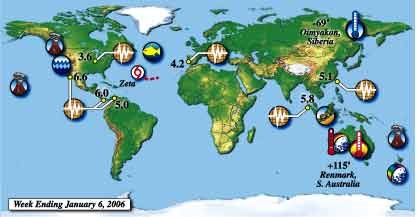UV Hot Spot
New Zealanders are being exposed to about 40 percent more
cancer-causing solar radiation than North Americans living at
similar latitudes, according to atmospheric scientists.
By Steve Newman
UV Hot Spot
New Zealanders are being exposed to about 40 percent more cancer-causing solar radiation than North Americans living at similar latitudes, according to atmospheric scientists. Summertime levels of ultraviolet radiation recorded in the country are so high that it is as if New Zealand has shifted four degrees in latitude toward the equator, and more than 3,000 feet higher in elevation. Scientists at New Zealand’s National Institute of Water and Atmospheric Research say that while the thinner ozone layer is partly to blame, the country’s clean air makes UV exposure even higher, along with being closer to the sun during its summer than North America.
Java Slide Disaster
A landslide on the Indonesian island of Java buried an entire village beneath tons of mud and rock as the number of people dead or missing from days of monsoon downpours climbed to more than 210. One man described watching helplessly as dozens of his neighbors were buried alive in Cijeruk, some screaming “Allah Akbar (God is great)!” as they disappeared beneath the mud. Other victims were either sleeping or performing Muslim prayers at the mosque when the mud, rocks and trees crashed onto the village just before dawn.
Record Hurricane Season
The 2005 Hurricane season broke yet another record when Tropical Storm Zeta formed in the mid-Atlantic. A total of 27 named storms formed from June through the end of December, far more than any other season since record-keeping began in the mid-1800s.
Earthquakes
Parts of the northwest Mexican mainland and Baja California were strongly shaken by a magnitude 6.6 temblor centered beneath the Gulf of California. No significant damage was reported.
Earth movements were also felt in Panama, northwest Venezuela, southern Illinois, southern Portugal, northwest Sumatra and Taiwan.
Hottest Year Ever
Australian Environment Minister Ian Campbell says new data shows 2005 was the country’s hottest year on record, providing further evidence of climate change. “It is a huge and serious challenge; these figures add to the weight of evidence that climate change is real and that it’s a problem that the world needs to work together to seek to solve,” he said. Bureau of Meteorology data shows the average temperature across the country last year was 73.2 degrees Fahrenheit.
California Floods
Days of heavy winter rainfall swamped parts of Northern California’s wine country, but vineyard operators insist there was no damage to the region’s prized grapevines. They say the vines were dormant and remained secured to trellises despite the rushing flood waters. But many houses, roads and businesses in the Russian River resort area were submerged, as were parts of upscale communities in Marin County. Gov. Arnold Schwarzenegger declared 16 counties, including Marin, Sonoma and Napa, disaster areas, opening the way for government assistance for repairing the estimated $200 million in flood damage.
Volcanoes
U.S. geologists say they are puzzled by the volume of lava Washington state’s Mount St. Helens has produced in recent weeks. Roughly 10 cubic yards of molten rock oozes from the mountain’s crater every three seconds, and scientists can’t determine if it is coming from within the mountain or from the depths of the Earth’s crust.
Earth tremors from within Hawaii’s Mauna Loa Volcano sharply declined during 2005 – a trend that may mean the volcano is less likely to erupt. High seismic activity a year ago led many geophysicists to believe that the volcano could erupt at any time.
Authorities in Vanuatu confirmed all of the 3,000 people displaced by Ambae Volcano last month have now gone back to their homes. An eruption in November poisoned most local water sources with ash.
Deep-Sea Damage
New research reveals that deep-sea fish species in the northern Atlantic are on the brink of extinction due to large-scale bottom trawling by the fishing industry. Writing in the journal Nature, lead scientist Jennifer Devine of Newfoundland’s Memorial University says some populations have plummeted by 98 percent in a generation, meeting the definition of “critically endangered.” Following the collapse of open water fish stocks, such as cod, bottom trawling has become more widespread. The process uses heavy trawls that are dragged across the ocean floor, destroying coral and other ecosystems.











